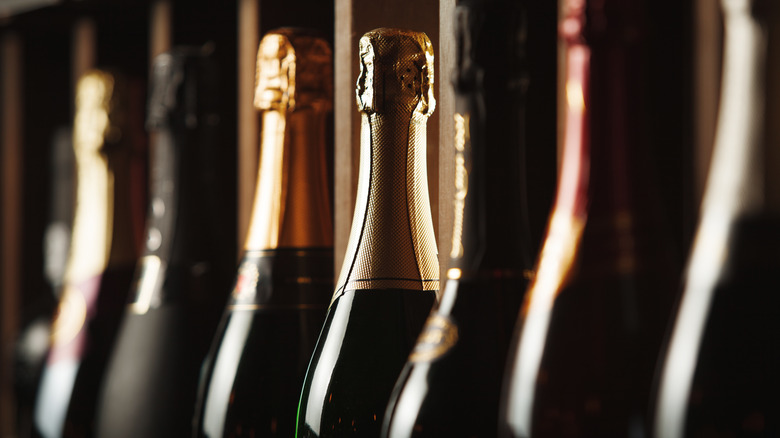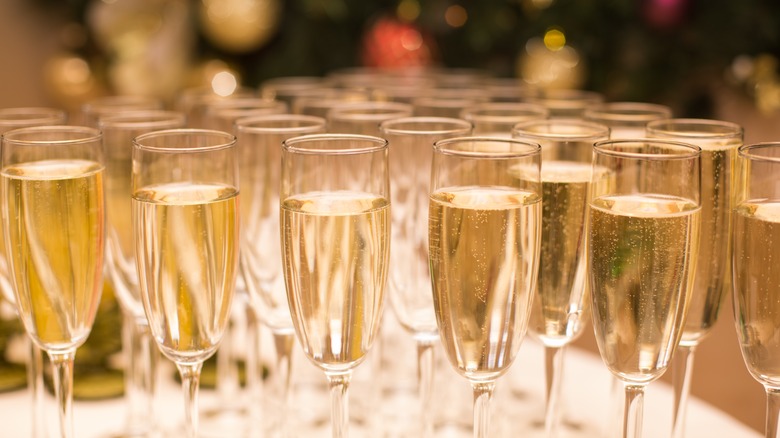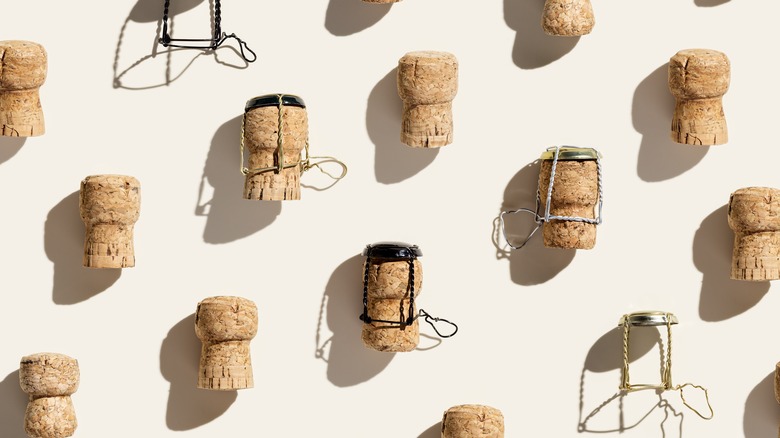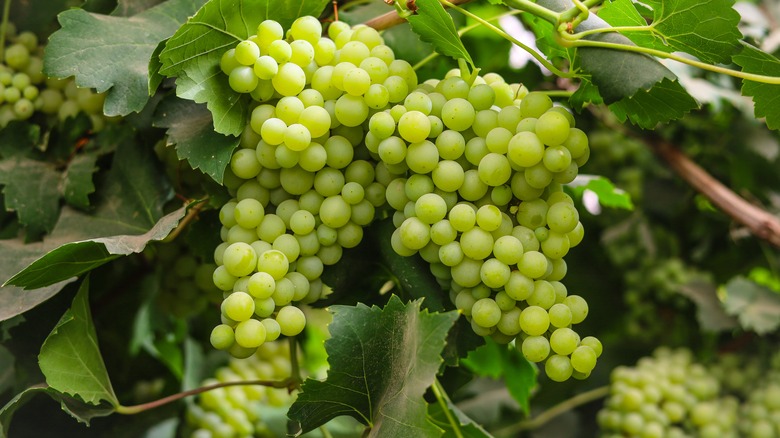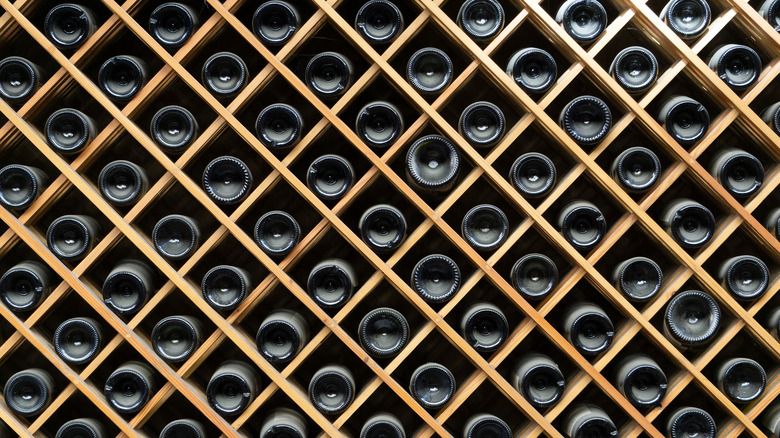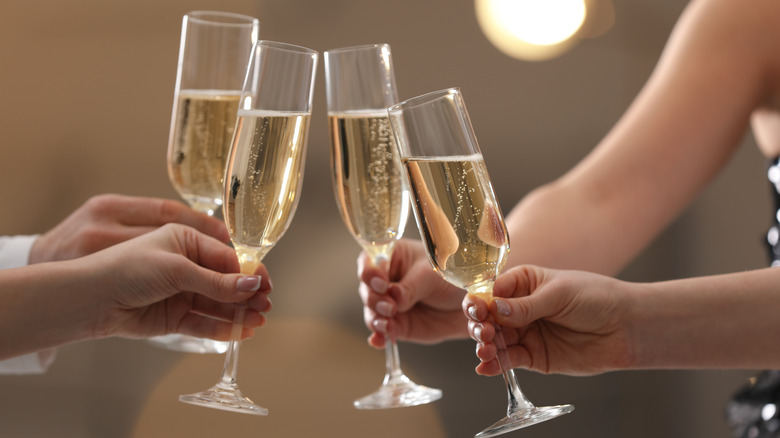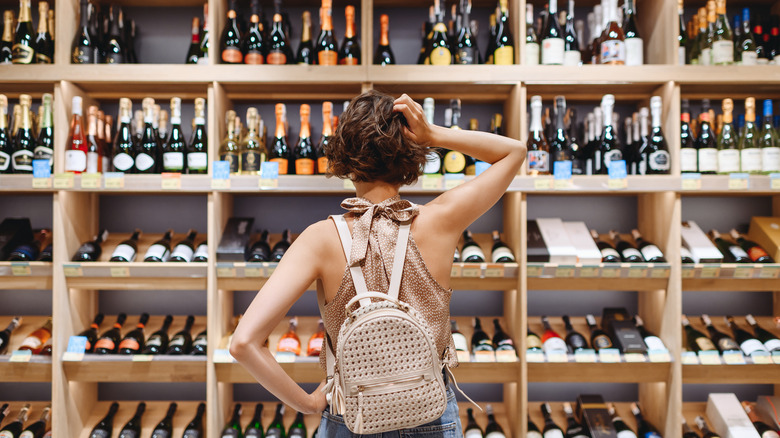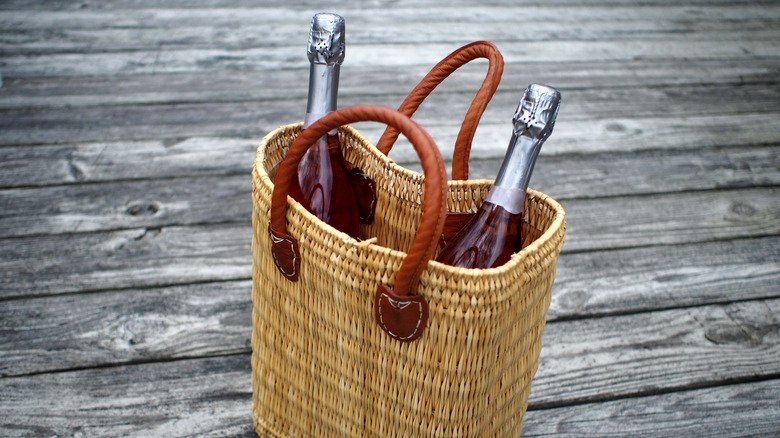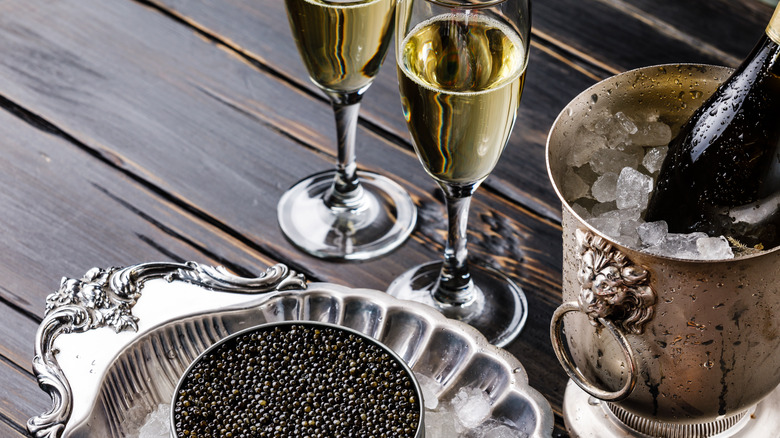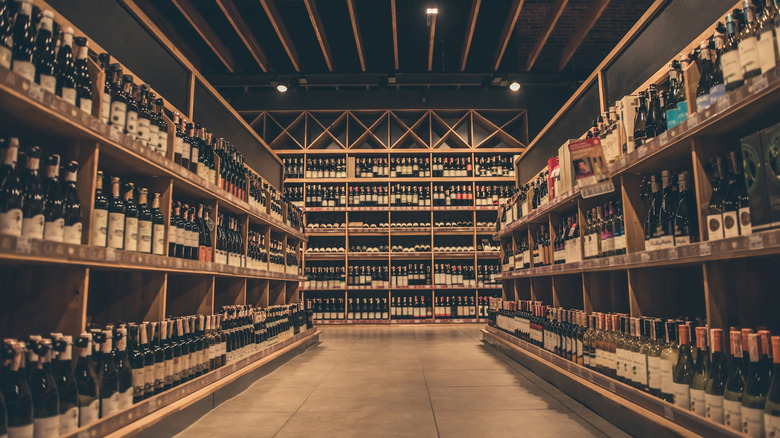What's The Difference Between Champagne And Prosecco?
When it's time to celebrate a special occasion, toast one of life's true joys, indulge in a boozy brunch, or just treat yourself to something classy and refreshing, you'll need a bottle of bubbly. However, as ubiquitous as the need for something alcoholic and effervescent may be, there's a world of differences between the options you'll find at the liquor store.
Many people wrongly assume that sparkling wine is sparkling wine, and throw around terms like "Champagne" and "Prosecco" without understanding what they really mean. So, before you pop the cork on your next bottle, it's a good idea to understand the differences between Champagne and Prosecco. Key differences include where and how they're made and what types of grapes go into each bottle. Understanding what sets each variety apart can help you find the ideal libation for your next celebration, choose perfect food pairings, and wrap your mind around why some bottles are so expensive. Plus, it never hurts to learn about a topic as fun and interesting as sparkling wine!
To help explain the nuances between these two beverages, we spoke to Jen Pelka, co-founder and CEO of Une Femme Wines (a women-founded and focused sparkling wine brand) to shine some light on the matter. Pelka also founded The Riddler, a champagne bar that had outposts in San Fransisco and New York City, so she's an expert on all things bubbly. Read on to learn everything you need to know about the differences between Champagne and Prosecco.
History
Let's start with a little history lesson. Champagne has a long, storied history that began centuries ago in Champagne, France. According to Smithsonian Magazine, the initial production was actually an accident that came about as the result of an unusually cold winter in the 15th century. The frigid temperatures halted the region's wine fermentation process, which restarted when things warmed back up.
This second fermentation resulted in more carbon dioxide than usual, which gave the wine its signature bubbles. At the time, this was an imperfect science, and bottles kept exploding until a monk named Dom Pérignon was called in to find a solution. Although Pérignon is generally thought of as the "Father of Champagne," records show that a British doctor actually developed a recipe six years before he did. Many modern Champagne producers have been around for hundreds of years, and Jen Pelka says that part of what she loves about the beverage is the "magnificent tales about how it's made and the houses that have been making it for hundreds of years."
Prosecco also has a lengthy history, and the grape from which it's made (more on that later) has roots that date back to Roman times, notes VinePair. Prosecco as we know it today got its start in the Conegliano Valdobbiadene region of Italy in the 1700s, and a wine school opened in 1876 that refined and perfected the growing and production methods (via Prosecco House).
Production regions
One of the most important distinctions between Champagne and Prosecco is where they're made. "Official Champagne must be made in the Champagne region of France with grapes that were grown there," says Jen Pelka. Bottles must meet this requirement to be labeled as Champagne, and since the region is small, the number of Champagne producers is self-limiting. The region is located east of Paris and is divided into five subregions that encompass 34,300 hectares of vineyards.
The regional requirements for Prosecco have changed over the years. Today, in order for a bottle to officially be labeled as Prosecco, it must come from the Prosecco region of Italy. This area, which lies in northeast Italy and spans five smaller subregions, was only officially designated in 2009. Although this region is smaller than the Champagne region, the overall output of Prosecco is higher than that of its bubbly French counterpart.
Even though the same grapes that are used to make Prosecco are grown in Australia, and the same production methods are used, the product Australian producers make can't actually be defined as Prosecco. Similarly, you'll find plenty of (generally inexpensive) brands like Andre or Korbel, that call themselves "California Champagne," but they are not technically true Champagne due to the region in which they were produced.
Many people don't understand this requirement, and it contributes to why you'll often hear people refer to any bottle of sparkling wine as Champagne or Prosecco, even when it really isn't.
Grapes
Not only are the regions in which the grapes are grown important in distinguishing these two beverages, but so are the grapes themselves. "The second big difference between the two are the varieties of grapes used. Champagne is most typically made from chardonnay, pinot noir, or pinot meunier grapes (arbane, petit meslier, and pinot gris are also allowed, but traditionally they're less frequently used). Prosecco is made primarily from the glera grape that grows in the Veneto and Friuli regions of Italy, " says Jen Pelka.
An important thing to note is that while there is a variety of grapes out there called champagne grapes (also called corinth grapes or zante currant grapes), this variety is not used to make Champagne. In fact, they're rarely used to make wine at all!
Another grape-related fact to know before you take another sip of Champagne (or Prosecco) is that even though Champagne is light in color, some of the grapes in the mix can be red. This is because the wine gets its color from the production method that's used, not the color of the grape.
Production methods
The methods used to make Champagne and Prosecco are more different than you may realize. These differences impact more than just the label on the bottle, as they also help impart each variety's signature flavors.
"The rule that I think most affects how Champagne tastes is that Champagnes always gets its bubbles during a secondary in-the-bottle fermentation process. A mix of sugar and yeast is added to the still wine and it's capped and stored to allow the yeast to convert the sugar to alcohol and carbon dioxide," says Jen Pelka.
Once Champagne has gone through this process, Pelka explains that the bottles are left with a by-product called "lees," which are essentially spent yeast cells. The bottles rest on the lees for a minimum of 15 months, after which "the bottles then go through a process called riddling to move the lees to the neck of the bottle, where they're then removed in a process called disgorgement," says Pelka. Since some of the liquid is lost in this process, Pelka says it's replaced with still wine (called a dosage) before it's corked.
Unlike Champagne, Prosecco gets its bubbles before bottling. "Prosecco goes through a secondary fermentation process called the Charmant method, where the fermentation happens in a large stainless steel tank instead of in the bottle," says Pelka. Differences aside, "both methods, when done right, can produce extraordinary wines," says Pelka.
Taste
Now that you know the basics about what's considered Champagne versus Processo, you're probably wondering: What do the final products taste like? While there are different styles of both varieties that play an important role in the individual flavors of each brand and bottle, there are a few generalizations that can be made about the two major categories. "There is generally a difference in how the two wines taste," says Pelka.
"Certain vintages and producers have their own unique characteristics, of course, but generally, Prosecco has a fruity and bright character. It's a light bubbly that often shows apple, melon, and pear flavors," says Pelka.
On the other hand, Pelka says that "Champagne, which spent a lot of time aging on that spent yeast, often gives off what I call bakery notes — hints of brioche, biscotti, and toasty bread. It can also have some fruity notes, but I usually find that Champagne has stronger moments of floral and citrus-like flavor characteristics than Prosecco."
How you drink both varieties of bubbly also matters — but the best option might surprise you. "Sparkling wines are best to drink not out of a flute, but out of a regular wine glass. Champagne, Prosecco, and sparkling wines are just that: wine. You can enjoy all of their characteristics (especially their aromas and taste) best when served from a wine glass," says Pelka. "Champagne is all about subtlety and nuance, and to really understand it, try your bottle out of wine glasses."
Varieties
It's time to dig deeper and talk about the varieties and classifications of both Champagne and Prosecco. In the case of Champagne, the main distinction is all about one main factor: sweetness. The most important word here is "brut," which essentially means dry, notes Wine Spectator. In terms of the different classifications, all you need to know about Champagne is that there are extra brut, brut nature, and nondosé (which are extremely dry), brut and sec (which are very dry and dry, respectively), and then demi-sec and doux (which are sweeter). Most of the common Champagnes you'll find at restaurants or wine shops tend to lean toward the drier side.
Remember how we said that there can be red grapes in Champagne? Well, although that's true, there are also specific categories of Champagne that are made from only white Chardonnay grapes called blanc de blancs, and only red grapes (blanc de noirs).
There are different types of Prosecco for every occasion, which can be defined by production area, and which also correlates to quality. Prosecco can be either DOC or DOCG, with DOCG being the higher quality option, since it must meet stricter qualifications. The DOCG category is further broken down into DOCG Superior and DOCG Rive.
With all the variety out there, the best way to figure out what you like is to drink up. If you're like us, convincing you to pour a glass or two of bubbly in the name of "research" isn't a difficult feat.
Price
Now, you're probably wondering how much each bottle of bubbly is going to set you back — and why. The answers come down to a few factors.
"Proseccos are much less expensive than Champagnes, primarily because the second fermentation in-tank versus in-bottle makes them much faster to produce," says Jen Pelka. However, there are some expensive bottles of Prosecco out there, since "some Proseccos have become more expensive because of special production methods like hand-harvesting grapes from steep hillsides called rives," says Pelka.
Although a few bargains do exist when it comes to Champagne, such as this $20 Kirkland brand option, most bottles of Champagne are going to run you more. "Champagne can range in price from $50 a bottle to well over $500 — especially for "grower-producer" wines from Champagne that are from particularly special vineyard plots with small yields, or that have been aged for many years," says Pelka. Champagne is undeniably associated with luxury, and as with most luxury goods, there is a price to pay.
Alternatively, there are plenty of bottles of Prosecco that go for $10 to $20, so we recommend going the Italian route if you plan on using it for something like mimosas. Save your Champagne for a toast!
Brands
There are a plethora of brands of each style of sparkling wine to choose from that range from large, nationally recognized icons, to small, craft producers, to brands that forge their own path by re-imagining the entire sparkling wine space. Jen Pelka's brand, Une Femme Wines, for example, produces Champagne, but also sparkling wines from California.
Popular Champagne brand giants include Moët & Chandon, Veuve Clicquot, Krug, Dom Pérignon, Bollinger, and Tattinger. Many of these brands have been around for centuries.
If you need a Prosecco buying guide, popular Prosecco brands include La Marca, Mionetto, and Cinzano. It's worth trying out a variety of brands and styles to discover your preferences. If you want something bubbly, but don't want Champagne or Prosecco, alternative options are becoming more prevalent. "While Champagne has my heart, I've also fallen for sparkling wines that may not be classified as Champagne, but are crafted to rival it. Producers are getting better and better at making sparkling wines using Charmant and other methods, and there are California winemakers who are crafting beautiful sparkling wines in very modern styles," says Jen Pelka.
When it comes to bubbly, popping a bottle isn't the only option anymore. "Canned sparkling wines are here to stay. At Une Femme, our canned California sparkling and California sparkling rose have been hugely popular because they're accessible in price points and easy to tote around. I'm all in on canned wines when they're high quality," says Pelka.
Food pairings
Another important thing to consider when deciding whether to opt for a bottle of Champagne or Prosecco is what foods pair best with each. Luckily, the options are nearly endless. "Sparkling wines are some of the easiest and most delicious to pair with foods," says Jen Pelka. While we share the mindset that there are very few meals where a glass of bubbly wouldn't be a welcome addition, some foods are better suited to complement certain bottles.
When it comes to Champagne, Pelka says, "I like to pair Champagne with anything that has good salinity — like a bowl of warm castelvetrano olives, oysters on the half shell, or latkes topped with sour cream (and if you can make it happen, caviar)."
If you want to branch out and take a walk on the metaphorical sparkling wild side, some unconventional foods to pair with Champagne include fried chicken, corn dogs, and apple pie. Don't be afraid to experiment!
On the other hand, "Prosecco has great acidity and is often slightly sweet, so I like to pair it with foods that are rich and maybe even a little spicy. I particularly like Prosecco with toro sushi, a flavorful green curry, or a bagel loaded with nova lox and cream cheese," says Pelka.
Shelf life
How long can a bottle of Champagne or Prosecco last? It all comes down to how they are stored and whether or not they've been opened. But, as you could probably guess by now, the answers for each variety are very different.
As far as Champagne goes, the most important thing to understand is the difference between vintage and non-vintage bottles. You can determine if a bottle is vintage or not by checking to see if there is a year on the bottle. If there is, you've got yourself a vintage bottle, which means the grapes it contains were produced in a single year. If not, then it's non-vintage, which means the grapes came from a variety of different years' crops (via Advanced Mixology).
When stored correctly, (at a regulated temperature in a wine cellar or wine fridge and away from harsh light), an unopened vintage bottle can last up to 10 years, and an unopened non-vintage bottle can last up to five years. Prosecco has a shorter shelf life, and unopened Prosecco should be consumed within three years of being bottled.
Once both Prosecco and Champagne are opened, the clock starts ticking. Drinking them immediately after opening is ideal, as they start to lose carbonation as soon as the bubbles are allowed to escape from the bottle. It is possible to stretch the timeframe out slightly with a special cork, but the product will start to lose flavor and quality as soon as the cork is popped.
